Today's workforce is more global than ever, with the shift to hybrid and remote working during Covid-19 fundamentally changing how companies build their teams.
The latest data from Ravio’s 2026 Compensation Trends report shows this clearly, with hybrid working by far the most used model across Europe – with particularly high adoption in the Netherlands and France (both 96% of companies) – and remote working common too, especially in Germany (48%) and Sweden (49%).
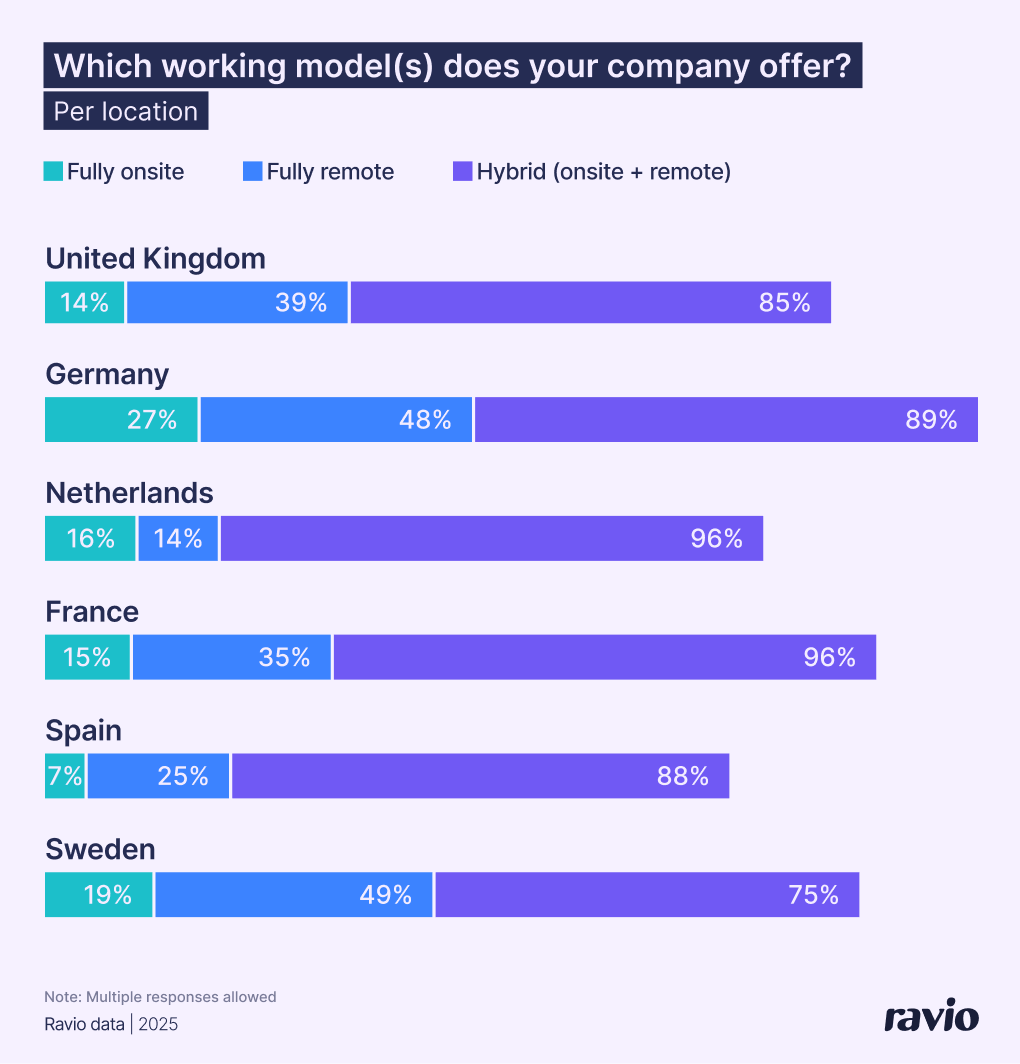
Naturally, this means that the question “should we pay employees differently based on where they work?” has become increasingly important for HR and Reward Leaders.
There are three common approaches:
- Location based pay: Salaries are fully differentiated using local market benchmarks for each location to account for differences in cost of labour across markets.
- Geographic pay differentials: Using the HQ country as a baseline, companies apply a multiplier to adjust salaries for other locations (sometimes based on location tiers, rather than each individual location).
- Location agnostic pay: All employees are paid using HQ location benchmarks, regardless of where they work from.
Each approach has benefits and trade-offs. Let's explore them.
“When it comes to choosing between global or local pay rates, both have their upsides and downsides. The question is: which one suits your organisation's setup, challenges and current phase the best? But here's the deal – don't just let it happen. Make a deliberate choice.”
Subscribe to our newsletter for monthly insights from Ravio's compensation dataset and network of Rewards experts 📩
Approach 1: Location based pay
What is location based pay?
Location based pay is a compensation strategy where employee salaries are adjusted based on the location they work from – so two employees in the same role might have different salaries depending on whether they're based in London, Bucharest, or Nigeria.
It accounts for differences in cost of labour across locations, with key factors including local talent demand, cost of living, and differences in employment taxes per location.
What are the advantages of location based pay?
The benefits of location based pay include:
- Market competitiveness in every location. By using local salary benchmarks, you ensure salaries are competitive wherever your employees work. This helps you attract and retain talent globally without overpaying in lower-cost markets or losing candidates in higher-cost ones.
- Internal fairness. When salaries reflect local markets and purchasing power, it ensures that employees in different locations have a similar disposable income. A £50,000 salary in London and a £39,000 salary in Manchester might be equivalent once those differences are factored in.
- Financial sustainability. Location based pay helps control payroll costs by avoiding a one-size-fits-all approach. You're not paying San Francisco rates to someone in Warsaw, which means your compensation budget goes further.
What are the disadvantages of location based pay?
The downsides of location based pay include:
- Increased complexity. It adds an additional factor into your compensation structures, potentially meaning building out separate salary bands for every location you hire in – which means more bands to build, maintain, and communicate. For a company hiring across 50 global locations, that complexity adds up quickly.
- Perceived unfairness. While location based pay is often done to improve the fairness and competitiveness of employee salaries, it doesn’t feel like that to all employees. Someone doing identical work for less money simply because of where they live can feel undervalued.
- Relocation challenges. What happens when someone moves from London to Lisbon? Reducing their salary isn’t an easy conversation to have, but keeping it the same means flouting your core principles and creating inconsistencies across the team.
How do you implement location based pay?
1. Get access to reliable global salary benchmarks
Start with a compensation benchmarking provider like Ravio that offers global benchmarking data, to ensure a strong understanding of how salaries vary across the locations that your company hires in.
2. Use the benchmarks per location – but keep the philosophy consistent
Use your benchmarking data to find the appropriate market rate for each location, guided by your core compensation principles.
For example, if you target the 75th percentile for software engineers to attract top tech talent, apply that same percentile target when benchmarking in all locations where you hire engineers.
3. Build location-specific salary bands
Within each role family (e.g. Software Engineer), create separate bands for each location you hire in – London, rest of UK, France, Romania, and so on – with the range reflecting market rates per location, around your target percentile.
This then makes decisions on new hire salaries easy to make in each location, because you already have the underlying structures set up.
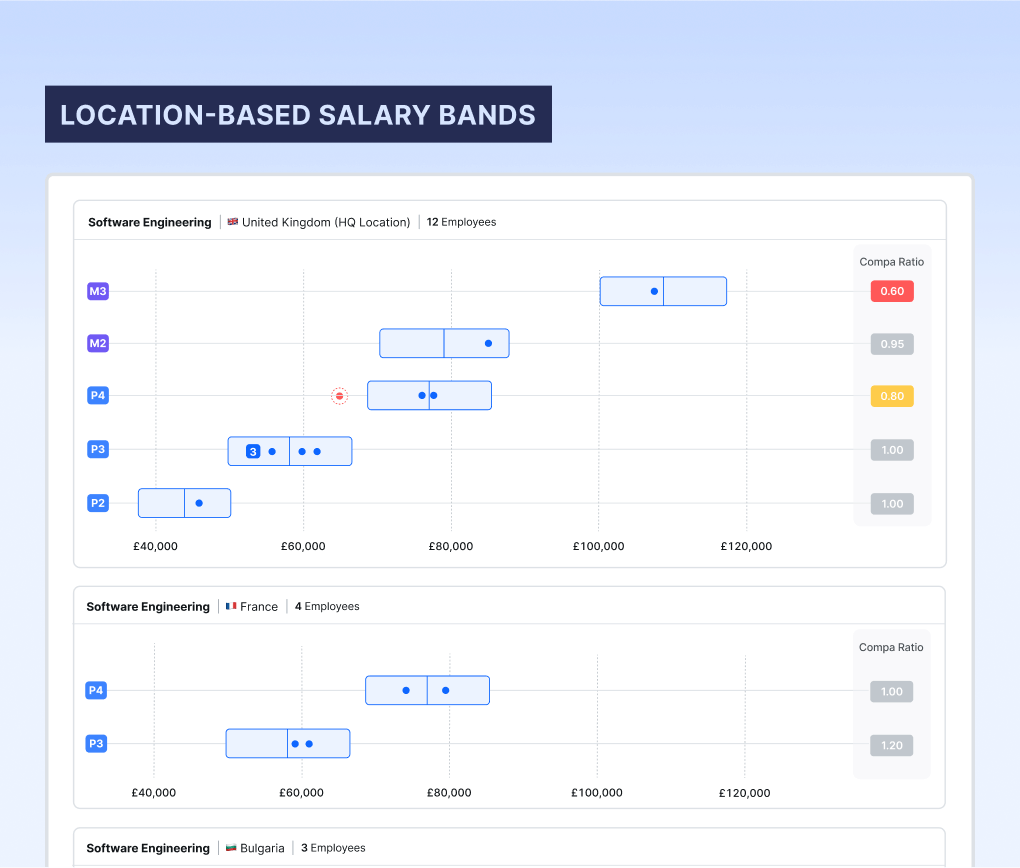
4. Make adjustments to bring employees in line with their location
If you're introducing location based pay to an existing compensation strategy, you'll likely need to make adjustments – some employees may now be underpaid relative to their local market, others overpaid.
Use compa ratio analysis to make fair adjustments. The compa ratio shows where an employee sits within their salary band, reflecting their performance and progression within their role – and so should stay consistent when you shift to location based bands.
Here's how to handle the transition:
- Calculate each employee's compa ratio in their current band before the change.
- Then move employees into their new location-specific bands and recalculate their compa ratio.
- If their compa ratio decreased, the employee is now underpaid relative to their band position. They should receive a market adjustment to restore their original band position – ideally immediately, or at the next compensation review.
- If their compa ratio increased, the employee is now overpaid relative to their band position. Decreasing salaries is inadvisable, so we recommend ringfencing these employees and freezing their salary until either market rates shift or their progression justifies an increased pay level. This prevents compounding internal equity issues.
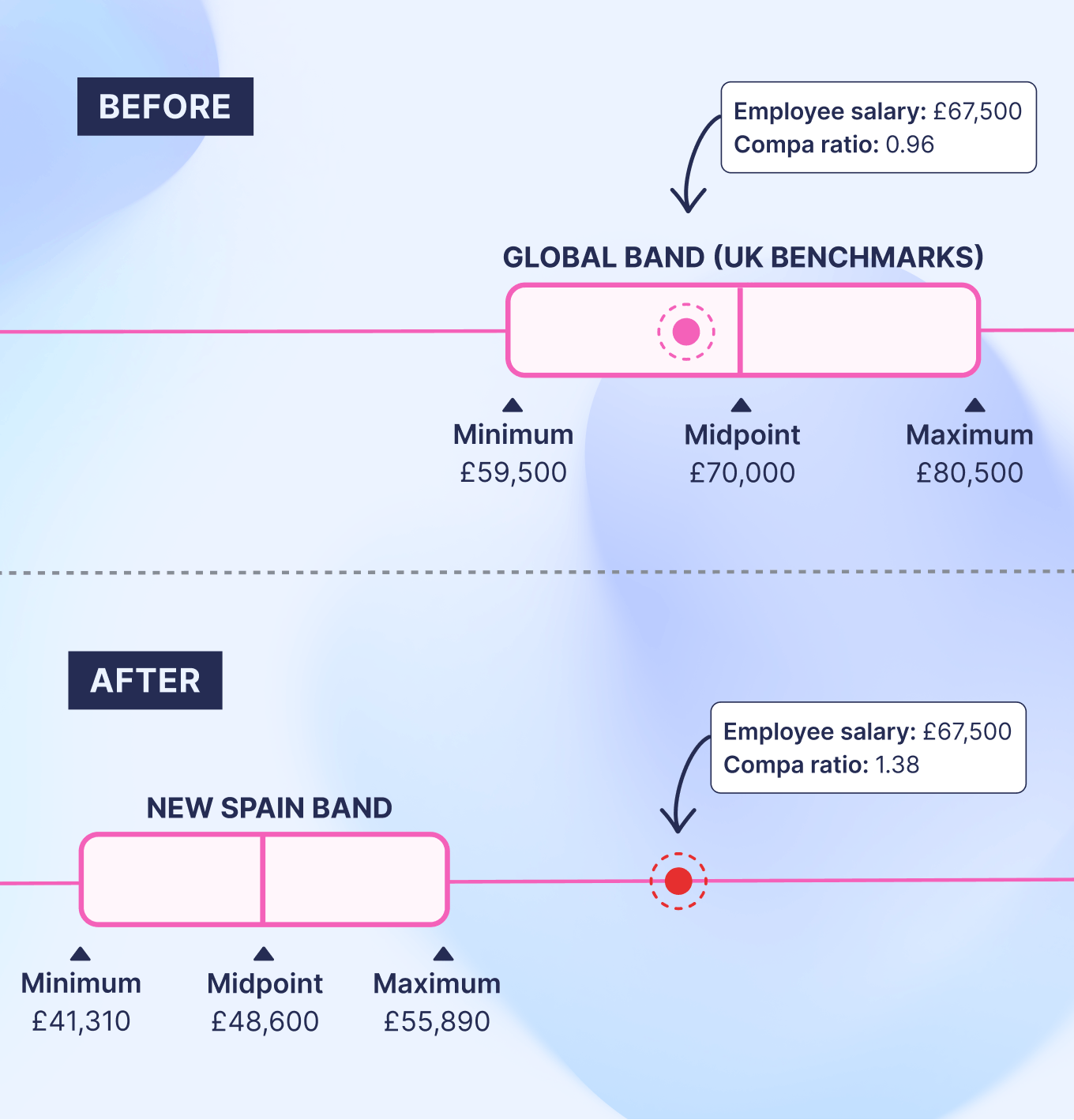
5. Review and refresh regularly
Labour markets shift at different speeds across locations. Review your underlying benchmarking data regularly (at least annually) and make market adjustments to ensure pay remains competitive per location.
Example: Ravio’s location based pay approach
At Ravio, we use location based pay to compensate our employees in line with the market where they work – ensuring we remain competitive locally, without overpaying globally.
We’re a hybrid company, with three types of employee location:
- London-based employees. UK employees who attend our required two in-office days per week at our London office (so London-based employees, or those close enough to commute) are benchmarked using Ravio’s London benchmarks.
- UK-based remote workers. UK employees who work remotely are benchmarked using Ravio’s UK-wide benchmarks, rather than London-specific market rates.
- Global remote workers. Remote employees based outside of the UK are benchmarked using Ravio’s benchmarks for their country of employment.
Approach 2: Geographic pay differentials
What are geographic pay differentials?
Geographic pay differentials adjust employee salaries based on their working location – using a baseline location (typically your HQ) and applying a multiplier to approximate market rates in other locations.
So instead of benchmarking each location individually, you might apply a 1.5x multiplier for US-based employees or a 0.6x multiplier for France-based employees – adjusting from your London baseline to reflect typical market differences.
There are three main variations:
- Geographic pay differentials: A unique multiplier for each location you hire in, based on market data showing how salaries differ from your HQ location on average.
- Cost of living multipliers: Using cost of living indexes to define the differential. We don't recommend this approach – cost of living is only one factor affecting market rates, and often not the most significant one (see disadvantages).
- Tiered differentials / multipliers: Grouping similar locations into tiers to reduce complexity – whether based on geographic pay differentials, or a cost of living multipliers. For example, Tier 1 (1.11x-1.5x HQ), Tier 2 (0.81x-1.1x HQ), Tier 3 (0.4x-0.8x HQ).

What are the advantages of geographic pay differentials?
The benefits of geographic pay differentials include:
- Simplicity. Instead of benchmarking every role in every location separately, you benchmark once in your HQ location and apply multipliers in a salary calculation – for this reason many startups opt for geographic pay differentials to implement a location based approach initially.
- Accounts for location differences. Geographic pay differentials recognise that market rates vary globally – helping you stay competitive in each location, without overpaying.
What are the disadvantages of geographic pay differentials?
The downsides of geographic pay differentials include:
- Less accurate than location-specific benchmarking. Multipliers approximate market rates but can't capture the nuances of local market rates for each role and job level across the business – 0.8x differential might be right on average but wrong for specific roles.
- Perceived inequity. Like location based pay, employees doing identical work receive different salaries based on location – which can feel unfair regardless of the methodology.
- Risk of relying on cost of living alone. Many companies use cost of living indexes to set differentials, but this ignores other critical factors like local talent supply and demand, which often have a bigger impact on market rates, meaning pay can stop being fair and competitive across locations.
How do you implement geographic pay differentials?
Option 1: Use a salary formula to apply the geographic differentials
Apply the geographic pay differential as a direct calculation when making new hire salary offers or salary adjustments for existing employees:
HQ benchmark × geographic differential = location-adjusted salary
For example, the current median salary for a P3 Software Engineer in the UK is £70,000 (Ravio benchmarks, September 2025) and the differential between the UK and France is 0.75x.
So if you were targeting the 50th percentile for a new hire based in France, this would give:
£70,000 x 0.75x = £52,500
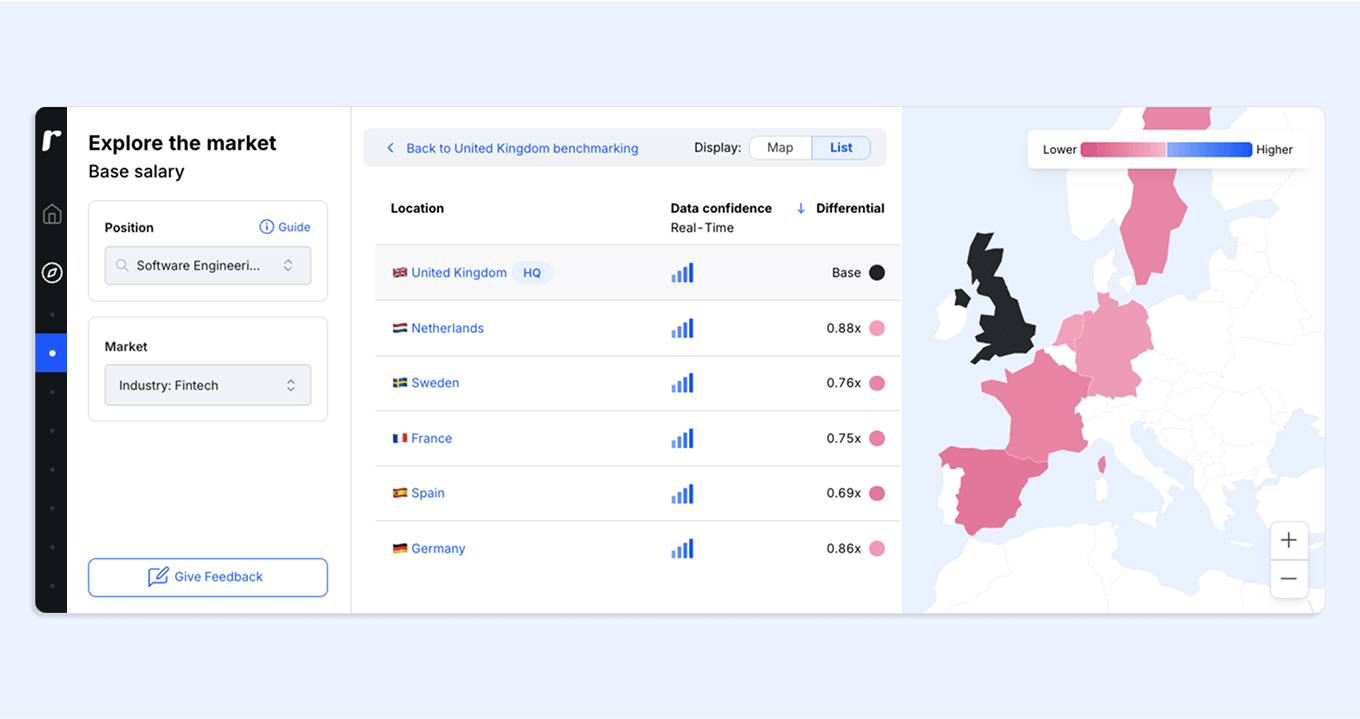
Option 2: Build location-specific bands using differentials
Using the same example: if your UK P3 Software Engineer band is £59,500-£80,500 (with a £70,000 midpoint at the 50th percentile, ±15%), your France band would be £44,625-£60,375 (with a £52,500 midpoint, still ±15% range) – calculated by applying the 0.75x differential to each band element.
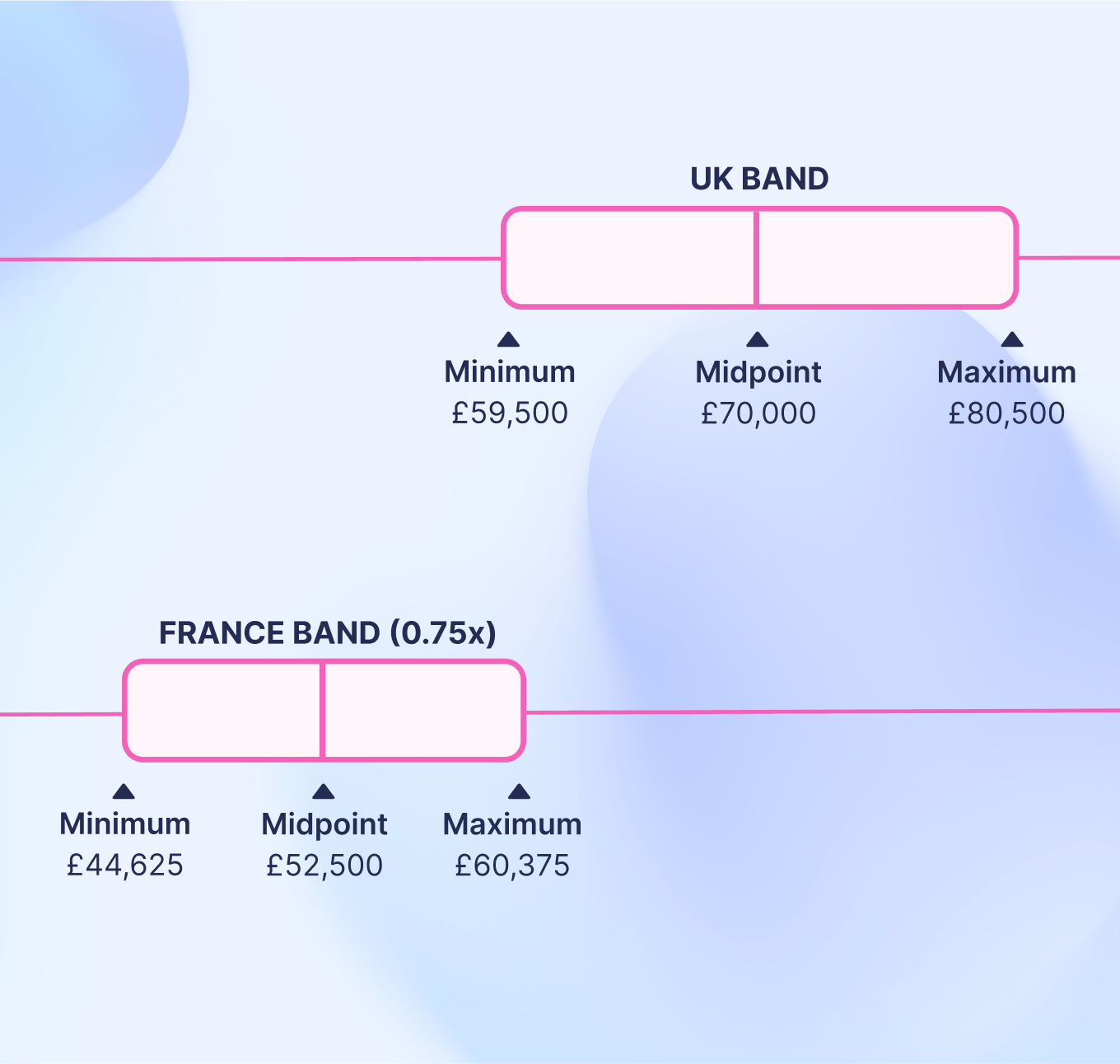
This adds structure and makes hiring decisions clearer, while still being simpler than benchmarking each location individually.
Example: Buffer’s Cost of Living multiplier
Buffer uses a tiered cost of living approach to set salaries globally.
San Francisco is used as their base location, to ensure highly competitive pay for all global employees.
So, for example, a P3 Software Engineer has a median base salary of $169,400 in Tier 1 US locations (Ravio benchmarks, September 2025).
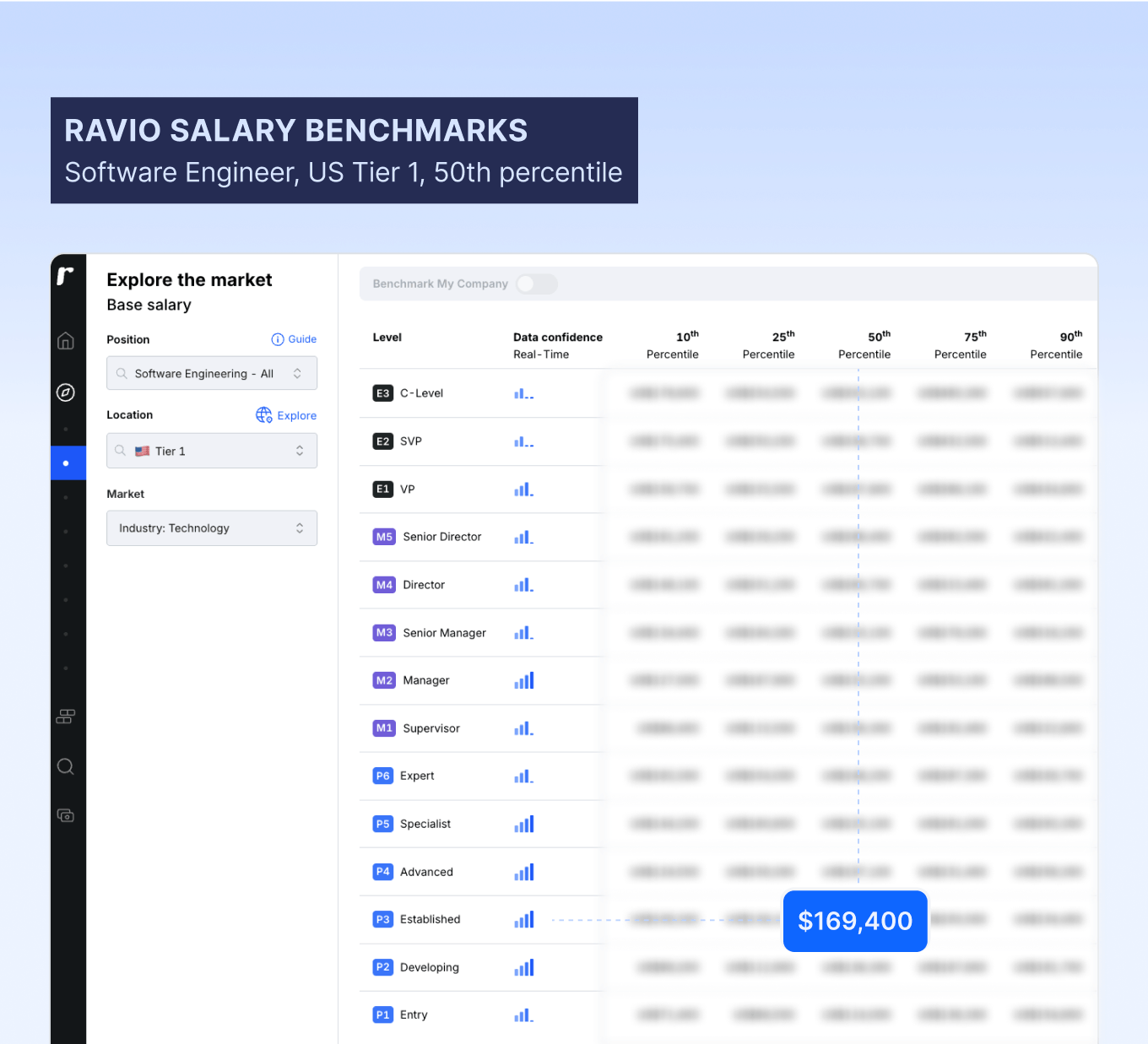
Buffer then uses Numbeo's Cost of Living Index to group locations. High cost of living locations – those roughly equal to or above San Francisco – include Zurich, New York, London, and Los Angeles.
Employees in these locations receive 100% of the base salary benchmark.
All other locations have a 90% cost of living multiplier applied to account for the lower cost of living compared to colleagues – aiming to keep pay equitable across the team.
So, a P3 Software Engineer based in Germany and targeting the 50th percentile would earn $152,460 – still highly competitive, but slightly lower than the San Francisco benchmark.
Approach 3: Location agnostic pay
What is location agnostic pay?
Location agnostic pay means employee salaries do not account for their working location – so two employees who do the same role at the same job level will receive the same salary, regardless of where they live.
This approach removes geography as a factor in pay decisions entirely. Companies typically benchmark against a single baseline location – often their HQ or a region that represents their target market – and use that market rate to inform their pay approach across all locations.
What are the advantages of location agnostic pay?
The benefits of location agnostic pay include:
- Maximum simplicity. You maintain a single salary structure with no location adjustments. One benchmark process, one compensation framework, one set of bands – making it the simplest approach to build and maintain.
- Removes geographic bias from hiring decisions. When every location costs the same, you eliminate the temptation to favour cheaper markets or avoid expensive ones. Hiring managers can focus purely on finding the best person for the role, regardless of where they live – without payroll cost considerations influencing the decision.
- No changes needed for relocations. When employees move countries, their pay stays constant. This removes difficult conversations about salary reductions and supports a globally mobile workforce – which means it can be attractive for remote workers.
- Rewards value over geography. Some companies view location agnostic pay as the fairest approach – paying people for the value they deliver rather than where they happen to live. It removes geographic bias from compensation decisions entirely.
What are the disadvantages of location agnostic pay?
The downsides of location agnostic pay include:
- Pay won't be competitive everywhere. Market pay rates differ by location, so you'll likely be underpaying in high-cost markets (like San Francisco, London, or Zurich) and overpaying in lower-cost markets (like Lisbon, Warsaw, or Bangalore) – unless you choose to pay everyone at the highest possible market, which is costly. This makes attracting talent difficult in expensive cities where your competitors use local market rates.
- Requires exceptional total rewards. To compensate for uncompetitive base pay in certain markets, you need a compelling value proposition beyond salary – whether that's equity, flexibility, mission, or learning opportunities. Base pay alone won't win top talent in high-cost locations where your salaries don’t match market rates.
- Potential internal tensions on fairness. While the company views equal pay as fair, employees in high-cost locations may feel disadvantaged when local living costs consume more of their salary, leaving them with a higher disposable income than their peers.
How do you implement location agnostic pay?
- Decide your baseline location. This becomes your reference point for all compensation decisions, so select a market that aligns with your company's stage, values, and target talent pool. Most companies use their HQ location, but some choose to benchmark against premium markets like San Francisco to ensure highly competitive pay globally (though this significantly increases payroll costs).
- Access reliable benchmarks for your chosen location. These will inform your compensation decisions across the entire employee base. Ideally you should use the benchmarks to build a salary band structure for the organisation, aligning also with your compensation philosophy on factors like target percentile.
- Handle the transition carefully if switching from location based pay. Moving from a location based approach means some employees' salaries will now sit well below the baseline benchmarks, others well above. Treat these likesalary band outliers: fix underpayments as soon as possible with market adjustments, and ringfence those now overpaid, pausing future salary increases to prevent the issue compounding over time.

Example: TestGorilla’s location agnostic pay approach
TestGorilla, a talent assessment platform, has used location agnostic pay since day one – and has maintained this approach as they've scaled to 150+ people across 50+ countries.
Their approach stems from two core principles in their compensation philosophy:
- Access: democratising opportunities regardless of location, in alignment with their product mission of democratising opportunities through skills-based hiring.
- Fairness: equal pay for equal work – as Head of People and Culture Olive Turon put it when she shared the approach in a Ravio Reward Hour: "A dollar is a dollar at TestGorilla."
So how does it work?
TestGorilla uses ‘Europe’ as the location to benchmark all roles against. The company’s HQ is in Amsterdam, so many of the team are based in Europe.
More strategically, Europe acts as “a mini version of the world” (Olive Turon) because there’s a lot of variance in salary benchmarks across Europe – from higher-cost markets like the UK and Netherlands to lower-cost ones like Portugal or Romania – making it a reasonable proxy for a global average.
TestGorilla knows their base pay isn't competitive in expensive markets like the US, and they're comfortable with that trade-off because of their clarity on core principles.
They offset lower base pay with compelling total rewards: unlimited PTO, flexible hours, substantial L&D budgets, and mission-driven work.
This appeals to people who value flexibility and purpose over maximum base salary – which means they do still hire in higher-cost markets, with the UK as one of the company’s largest talent pools, despite it being a higher cost talent market in Europe.



